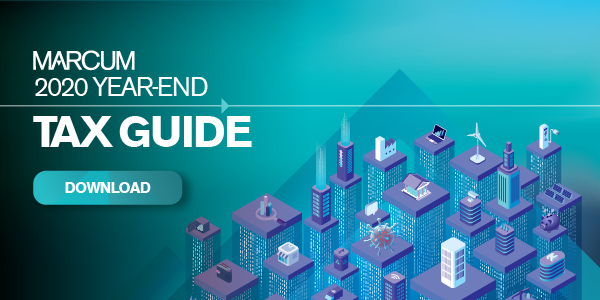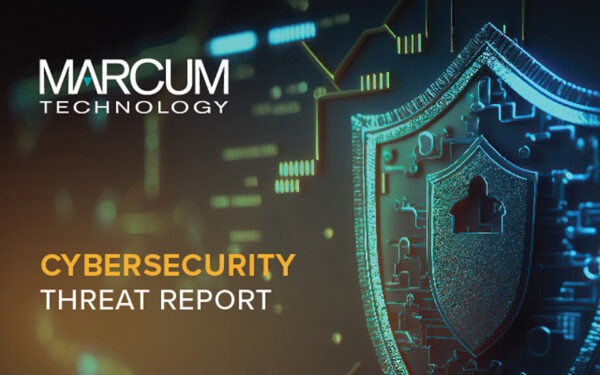A Busy Year for Nonprofit Tax Guidance
Without even taking into consideration the major disruption caused by the coronavirus pandemic, 2020 has been a very busy year for those involved with nonprofit organizations. Contributing to the pace of change is much new guidance related to recent legislation and other-long awaited items. It started with an early holiday present at the end of 2019, when the controversial and universally despised “parking tax” was retroactively eliminated. At the same time, the long-discussed modification of investment income tax rates for private foundations was implemented.
In addition, proposed regulations related to unrelated business income “silo” rules, as well as proposed regulations related to excess compensation rules, were published. Finally, the IRS issued Notice 2020-36, which provides a proposed revenue procedure related to updating and modifying the group exemption process.
While covering comprehensive discussion about all of the nuances of these very technical issues is beyond the scope of this guide, below is a general summary and a couple of key points related to each.
PARKING TAX
The Tax Extender Bill signed by President Trump at the end of 2019 included the full and retroactive repeal and the elimination of the tax imposed on qualified transportation benefits, otherwise known as “the parking tax.”
The IRS issued guidance for tax-exempt organizations claiming a refund or credit of unrelated business income taxes paid due to the revisions to this law. To claim a refund or credit of the tax originally reported on Form 990-T, the IRS states that organizations should file an amended Form 990-T for the year in which the tax was paid and provides specific guidance depending on the year being amended.
This brings an end to one of the most controversial tax topics that has faced nonprofit organizations in many years.
NET INVESTMENT INCOME TAX CHANGE FOR PRIVATE FOUNDATIONS
Excise taxes on private foundations were simplified by the 2020 Appropriations Act. Under the rules, the private foundation paid either a 1% or 2% excise tax on net investment income depending on its current year qualified distributions compared to average distributions over the prior five years. This two-tiered tax rate has been eliminated, and the excise tax on net investment income for private foundations was changed to a single rate of 1.39%. This change is effective for tax years beginning after December 20, 2019.
PROPOSED REGULATIONS RELATED TO “SILO” RULES (SECTION 512(A)(6))
On April 23, 2020, proposed regulations were issued related to IRC Section 512(a)(6), which was enacted as part of the 2017 Tax Cut and Jobs Act (TCJA). This code section requires exempt organizations to calculate unrelated business taxable income separately with respect to each of their unrelated trades or businesses, thereby limiting the ability to use losses from one business to offset income from other taxable activities.
The proposed regulations included much of the interim guidance provided in previously issued notices. Some takeaways from the proposed regulations include: (i) a simplified process by which to classify various business activities for purposes of determining taxable income; and (ii) relief and guidance in applying certain aggregation rules, which focus on income flowing from various alternative investment structures.
One major change in the proposed regulations was the use of two digit North American Industry Classification System (“NAICS”) sector codes as the primary method for identifying separate trades or businesses, rather than the six-digit codes suggested in the prior notice. This greatly reduced the number of trades or businesses from more than a thousand to a mere 20, which will greatly reduce the compliance burden for many exempt organizations.
Under the proposed regulations, all investment activities are treated as a single and separate unrelated trade or business. For this purpose, investment activities are limited to the following three activities only: (i) direct or indirect investments in partnerships designated as “qualifying partnership interests” (“QPIs”), (ii) debt financed properties, and (iii) qualifying S corporation interests.
GUIDANCE ON NET OPERATING LOSSES (NOLs)
The proposed regulations provide that NOLs arising in taxable years beginning after December 31, 2017, are to be applied to each separate trade or business. The TCJA amended Internal Revenue Code section 172, in most circumstances, to eliminate NOL carrybacks, limit net operating losses to 80 percent of taxable income, and allow carryforwards indefinitely. Pre-TCJA taxpayers could generally carry back losses for two years and forward for only 20 years.
The Coronavirus Aid, Relief, and Economic Security (CARES) Act modified this code section to address liquidity issues arising from the COVID-19 pandemic by temporarily repealing the 80 percent NOL limitation and allowing deductions for loss carryovers and carrybacks to fully offset taxable income for tax years beginning before January 1, 2021.
The law also allows nonprofit companies to carry back losses arising in tax years 2018 through 2020 for up to five years before the year of the loss. The CARES Act made the TCJA NOL rules effective for tax years beginning after December 31, 2020, along with fixing legislative quirks such as the effective date for fiscal-year taxpayers, and clarifying how taxpayers deduct both pre-TCJA and post-TCJA NOLs.
PROPOSED EXCESS COMPENSATION REGULATIONS (SECTION 4960)
Section 4960 imposes an excise tax on remuneration in excess of $1 million and any excess parachute payment paid by an applicable tax-exempt organization to any covered employee. In December 2018, the IRS issued initial guidance in Notice 2019-9 on the application of section 4960. The proposed regulations issued on June 5, 2020 are generally consistent with that guidance but include changes to address comments.
The proposal indicates that federal instrumentalities would be subject to section 4960. It also states that a foreign organization would be treated as an applicable tax-exempt organization (“ATEO”) unless it receives substantially all its support (other than gross investment income) from sources outside the United States.
One big question that many were looking to be addressed is that of volunteers who are not compensated by the nonprofit but received substantial compensation from potentially related for-profit organizations. The proposed regulations state that amounts paid to an individual who was never employed by the ATEO in question is not considered for purposes of section 4960. Similarly, an individual who provides services solely as an employee of a related organization, including a related organization that provides services to the ATEO, is not employed by the ATEO and therefore isn’t a factor when determining the ATEO’s five highest compensated employees.
When an employee of a related non-ATEO provides limited services to the ATEO without compensation, the proposed regulations would provide a limited-hours exception for determining the five highest compensated employees, if the hours of service the employee performs for the ATEO comprise 10 percent or less of the employee’s total hours of service for the ATEO and all related organizations during the applicable year. An individual would be deemed as having satisfied this requirement if the individual works no more than 100 hours for the ATEO and all related ATEOs during the year.
PROPOSED GROUP EXEMPTION REVENUE PROCEDURE
After 40 years, the IRS updated procedures under which recognition of exemption from federal income tax for tax exempt organizations described in Section 501 (c) may be obtained on a group basis for subordinate organizations affiliated with and under the control of a central organization. Notice 2020-36 sets forth updated procedures a central organization must follow to maintain a group exemption letter. The proposed revenue procedure updates Revenue Procedure 80-27, the IRS’s primary authority on group exemptions, which has been in effect since January 1980. The IRS also announced that it will not accept any requests for group exemptions until final guidance on group exemptions is published in the Internal Revenue Bulletin.
The IRS states in the proposed revenue procedure that its goals in updating Revenue Procedure 80-27 were to reduce that burden, increase efficiency, improve the integrity of data collected, increase transparency, and increase compliance by central and subordinate organizations. In addition to providing amended rules for group exemptions going forward, the proposed revenue procedure provides a transition rule and a grandfather rule to address how the changes would apply to preexisting group exemptions.
The proposed revenue procedure would add two requirements that a central organization would need to meet to obtain and maintain a group exemption: (1) have at least five subordinate organizations to obtain a group exemption and at least one subordinate organization thereafter; and (2) maintain only one group exemption.
Consistent with Revenue Procedure 80-27, the proposed revenue procedure would require a central organization to establish that each subordinate organization included in the group exemption be affiliated with the central organization and subject to its general supervision or control, but would require subordinates to meet the more specific conditions of affiliation, general supervision, and control. These requirements would require a much more uniform structure for all subordinate organizations and limit the ability to cover a variety of types of nonprofits under the same group exemption.
Unfortunately for the IRS, there has been a lot of immediate responses to these regulations, indicating a high level of concern by many organizations that heavily use group exemptions, especially religious organizations and other groups with diverse types of affiliated and subordinate organizations that feel the proposed regulations are not workable for these complex structures. The new requirements will not go into effect until the revenue procedure is finalized, and it will be interesting to see how the IRS reacts to the largely negative initial public response to its attempt to update and clarify the law in this area.
SUMMARY
As we move towards the end of another year, facing the results of a new election, and dealing with the impact of a global pandemic, we anticipate continued discussion about these and many more topics applicable to nonprofit organizations in the months ahead.
Contact your Marcum professional for assistance with any of the above or other issues of concern to your organization.




















